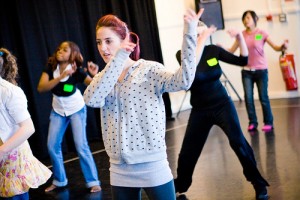Whenever I enter a new teaching environment, or a new academic year, the first thing I focus on is when we can start performing.
Now, please know that I don’t actually love the concertizing process or the added stress performance demands place within an educational setting.

Preparing for some type of culminating performance, however, does wonders for the students and the program as you plan for the content and experiences that may actually be more important.
What are these wonders, you ask?
Trusting their Peers
Rehearsing with a unified goal unifies the ensemble. It provides (or refreshes) the “buy-in” that I need for what I view as the really important content — the content that may not directly relate to performance — such as dance theory, dance history, and more.
Trusting their Instructor
Students recognize the choice to put them onstage (especially very early in the year or season), as an act of trust and truly view the opportunity as a gift. Therefore not only does the ensemble unite, they put their trust in me to lead them to exciting adventures.
Just as students appreciate my trust in them, students’ families learn to trust me to create interesting experiences for their child. Especially if I am challenging previous norms, they push back less when the stakes are a bit higher (like a year-end performance).
Trusting Themselves
Performance offers such a valuable opportunity for self-discovery and a better understanding of dependent relationships (such as relying on the other performers, the lighting designer, the sound technician, etc.), including how their actions impact others.
In the beginning of the year, most students expect these adventures to be on-stage but by the end of the year they tend to see that many exciting experiences took place in the studio/classroom and did not depend on lights and costumes.
Students become more open and willing to find adventure wherever it exists rather that where they think it should be.
Before the Big Show
Varied types of performances throughout the year takes much of the pressure off the “big spring show”.
I find that most students and families can’t wait for the larger performance, so having smaller opportunities (like the examples below) before that time can be a great way to stretch their perceptions of dance, dance performance, and dance education before the big day.
Site specific:
Creating unique dances specific to a certain location.
This could be presented as a “school tour” with dancers performing in non-traditional performance spaces (think classrooms, hallways, offices,….) or in another public setting such as a nearby park.
Informal showings:
Invite non-arts classes to view your students’ composition sketches or their concert piece before dress rehearsals begin. It can inspire conversations among students outside of class, or offer connections between class subjects.

Lecture/Demonstrations:
Coach your dancers to talk the talk as well as walk the walk.
Turning over responsibility to explain the concepts being explored in class to the audience watching expands the type of performance experience as well as reinforcing understanding.
Community:
Take the show on the road by offering free performances for local clubs and community groups.
Soon you may find an additional line of revenue for your group as these community organizations offer honorariums for your performances.
By the time the “big spring show” rolls around, your dancers will be prepared, open, and poised.
What kinds of informal performances have worked to prepare your students for the “big show”?
What other benefits does a year-end performance hold for your students?
Heather Vaughan-Southard MFA, is a choreographer, dance educator, and performer based in Michigan. She currently directs the dance program at the Everett High School Visual and Performing Arts Magnet in Lansing. With the philosophy of teaching dance as a liberal art, Ms. Vaughan-Southard collaborates with numerous arts and education organizations throughout the state. She has danced professionally in Chicago, Detroit, Los Angeles, and New York and has performed works by Mia Michaels, Lar Lubovitch, Donald McKayle, Billy Siegenfeld, Alexandra Beller, Debra Levasseur-Lottman, and Bob Fosse. As a choreographer, her work has been credited by the Los Angeles Times for “creating heat.” She has recently choreographed for the dance programs at Michigan State University, Grand Valley State University, Lansing Community College and is the former dance professor at Albion College. She is a regular guest artist and blogger for Dance in the Annex, an innovative dance community in Grand Rapids. Heather received her MFA in Dance from the University of Michigan, BFA in Dance from Western Michigan University and K-12 certification in Dance from Wayne State University. Read Heather’s posts.

